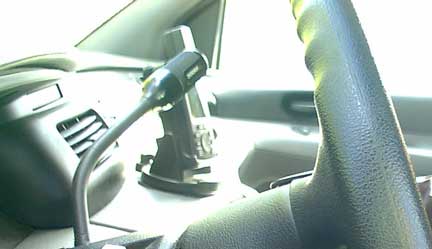 |
| FTLComm - Tisdale - September 13, 2000 |
 When I asked two officers about the unusual antennas on this convention Windstar, not unlike the FTLComm van the Peace Officer replied that it had something to do with communication. Either he didn't know or was being evasive The picture on the right shows the warning label on the Mitsubishi antenna mount on the aft roof of the van. The label indicates it is dangerous to be less than two feet from this antenna when it is activated. That would indicate that this is a "microwave" antenna, essentially the same sort of apparatus you use to cook with in your kitchen. These very short radio waves excite water molecules in tissue and increase their temperature. This suggests that this antenna is designed not to communicate with a ground based antenna but one orbiting the planet. It would appear that we have a satellite telephone installed in this van. |
 Besides this antenna the vehicle had four other whisker metal antennas for its cell, FM system and perhaps other accessories aboard. There is no indication as to what this sort of well equipped communication vehicle was doing here in town and it was not equipped with television equipment as we have seen in highway patrol vehicles. Because of the storage in the back it is likely that this vehicle is used by a crime investigation unit or "identification" unit specialising in evidence collecting and documenting a crime scene. With this satellite telephone system this vehicle could easily provide complete |
 data communications
to and data communications
to andfrom the rest of the world using a computer connected to this system. One of the interesting accessories on the dash of the van is a little gadget that is now standard equipment in most aircraft and a must for your average fishing boat. Mounted in the centre of this picture is a Magellan GPS unit (Global Position system) This inexpensive device ($179 from Canadian Tire) is a small computer that measures the timed signals from a series of orbiting satellites and with that information can determine with in thirty metres the device's position on the globe, including its altitude. The US military degrades the signal for the public so that the accuracy is not up to its maximum but their own equipment can locate a position within ten metres and perhaps even less. |